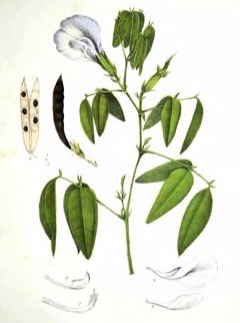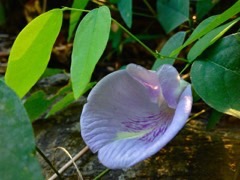 |
|
edibleplants.org |
 |
| Fritzflohrreynolds wikimedia.org |
Translate this page:
Summary
Physical Characteristics

 Clitoria mariana is a PERENNIAL CLIMBER growing to 0.8 m (2ft 7in) by 0.8 m (2ft 7in) at a medium rate.
Clitoria mariana is a PERENNIAL CLIMBER growing to 0.8 m (2ft 7in) by 0.8 m (2ft 7in) at a medium rate.
See above for USDA hardiness. It is hardy to UK zone 7.
It can fix Nitrogen.
Suitable for: light (sandy) and medium (loamy) soils, prefers well-drained soil and can grow in nutritionally poor soil. Suitable pH: neutral soils. It can grow in semi-shade (light woodland) or no shade. It prefers dry or moist soil.
UK Hardiness Map
US Hardiness Map
Synonyms
C. mariana var. mariana. C. marina L. [Spelling variant]. Martiusia mariana (L.) Small. Nauchea mariana (L.) Descourt. Ternatea mariana (L.) Kuntze. Vexillaria mariana (L.) Raf. Vexillaria mariana (L.) Eaton.
Plant Habitats
Edible Uses
References More on Edible Uses
Medicinal Uses
Plants For A Future can not take any responsibility for any adverse effects from the use of plants. Always seek advice from a professional before using a plant medicinally.
Aphrodisiac
The roots and seeds have been used medicinally, including as an aphrodisiac according to the ancient but unscientific doctrine of signatures.' but we have not been able to confirm this - Missouriplants.com
References More on Medicinal Uses
The Bookshop: Edible Plant Books
Our Latest books on Perennial Plants For Food Forests and Permaculture Gardens in paperback or digital formats.

Edible Tropical Plants
Food Forest Plants for Hotter Conditions: 250+ Plants For Tropical Food Forests & Permaculture Gardens.
More

Edible Temperate Plants
Plants for Your Food Forest: 500 Plants for Temperate Food Forests & Permaculture Gardens.
More

More Books
PFAF have eight books available in paperback and digital formats. Browse the shop for more information.
Shop Now
Other Uses
References More on Other Uses
Cultivation details
A temperate perennial forb. Stems are erect to reclining or trailing, to 1.2m, glabrous to sparsely pubescent with short, fine, curved hairs. It is a twining vine and not a climbing vine so is often found growing along the ground. In southern China it grows in forests between 100-2,000m above sea level. It grows in hardiness zones 6-9. Light Requirement: Sun, Part Shade. Preferred soil: Dry and Sandy. Bloom Color: Pink , Blue. Bloom Time: Jun to Aug. For polyculture design as well as the above-ground architecture (form - tree, shrub etc. and size shown above) information on the habit and root pattern is also useful and given here if available. Herbaceous. Growth habit is a single or multiple shooting vine from a crown [1-2].
References Carbon Farming Information and Carbon Sequestration Information
Temperature Converter
Type a value in the Celsius field to convert the value to Fahrenheit:
Fahrenheit:
The PFAF Bookshop
Plants For A Future have a number of books available in paperback and digital form. Book titles include Edible Plants, Edible Perennials, Edible Trees,Edible Shrubs, Woodland Gardening, and Temperate Food Forest Plants. Our new book is Food Forest Plants For Hotter Conditions (Tropical and Sub-Tropical).
Shop Now
Plant Propagation
Seed
Other Names
If available other names are mentioned here
Butterfly pea, Atlantic pigeon wings, Biec tim, Taw-peik-san, Taw-pesein,
Native Range
NORTHERN AMERICA: United States, Indiana (south), New Jersey, Ohio (south), Pennsylvania (southeast), Illinois (south), Kansas (Cherokee Co.), Missouri, Oklahoma, Alabama, Arkansas, Delaware, Florida, Georgia, Kentucky, Louisiana, Maryland, Mississippi, North Carolina, South Carolina, Tennessee, Virginia, District of Columbia, Texas, Arizona, Mexico, Chihuahua, Nuevo León, Sonora,
Weed Potential
Right plant wrong place. We are currently updating this section.
Please note that a plant may be invasive in one area but may not in your area so it's worth checking.
None Known
Conservation Status
IUCN Red List of Threatened Plants Status :

Growth: S = slow M = medium F = fast. Soil: L = light (sandy) M = medium H = heavy (clay). pH: A = acid N = neutral B = basic (alkaline). Shade: F = full shade S = semi-shade N = no shade. Moisture: D = dry M = Moist We = wet Wa = water.
Now available:
Food Forest Plants for Mediterranean Conditions
350+ Perennial Plants For Mediterranean and Drier Food Forests and Permaculture Gardens.
[Paperback and eBook]
This is the third in Plants For A Future's series of plant guides for food forests tailored to
specific climate zones. Following volumes on temperate and tropical ecosystems, this book focuses
on species suited to Mediterranean conditions—regions with hot, dry summers and cool, wet winters,
often facing the added challenge of climate change.
Read More
Expert comment
Author
L.
Botanical References
Links / References
For a list of references used on this page please go here
Readers comment
| Add a comment |
|
If you have important information about this plant that may help other users please add a comment or link below. Only comments or links that are felt to be directly relevant to a plant will be included. If you think a comment/link or information contained on this page is inaccurate or misleading we would welcome your feedback at [email protected]. If you have questions about a plant please use the Forum on this website as we do not have the resources to answer questions ourselves.
* Please note: the comments by website users are not necessarily those held by PFAF and may give misleading or inaccurate information.
To leave a comment please Register or login here All comments need to be approved so will not appear immediately.
|
Subject : Clitoria mariana
|
|
|
|